Pi
- Afrikaans
- Alemannisch
- አማርኛ
- العربية
- Aragonés
- অসমীয়া
- Asturianu
- Avañe'ẽ
- Azərbaycanca
- تۆرکجه
- বাংলা
- Banjar
- Bân-lâm-gú
- Башҡортса
- Беларуская
- Беларуская (тарашкевіца)
- Bikol Central
- Български
- Bosanski
- Brezhoneg
- Буряад
- Català
- Чӑвашла
- Cebuano
- Čeština
- Cymraeg
- Dansk
- Deutsch
- Dolnoserbski
- Eesti
- Ελληνικά
- Emiliàn e rumagnòl
- Español
- Esperanto
- Estremeñu
- Euskara
- فارسی
- Føroyskt
- Français
- Frysk
- Furlan
- Gaeilge
- Gàidhlig
- Galego
- 贛語
- ગુજરાતી
- Хальмг
- 한국어
- Hausa
- Hawaiʻi
- Հայերեն
- हिन्दी
- Hornjoserbsce
- Hrvatski
- Ido
- Bahasa Indonesia
- Interlingua
- Ирон
- IsiXhosa
- Íslenska
- Italiano
- עברית
- Jawa
- ಕನ್ನಡ
- ქართული
- Қазақша
- Kernowek
- Kiswahili
- Kreyòl ayisyen
- Kriyòl gwiyannen
- Kurdî
- Кыргызча
- Latina
- Latviešu
- Lëtzebuergesch
- Лезги
- Lietuvių
- Limburgs
- Lombard
- Magyar
- Македонски
- Malagasy
- മലയാളം
- मराठी
- مصرى
- Bahasa Melayu
- Minangkabau
- 閩東語 / Mìng-dĕ̤ng-ngṳ̄
- Монгол
- မြန်မာဘာသာ
- Na Vosa Vakaviti
- Nederlands
- नेपाली
- नेपाल भाषा
- 日本語
- Nordfriisk
- Norsk bokmål
- Norsk nynorsk
- Occitan
- ଓଡ଼ିଆ
- Oʻzbekcha / ўзбекча
- ਪੰਜਾਬੀ
- Pälzisch
- پنجابی
- پښتو
- Patois
- Picard
- Piemontèis
- Plattdüütsch
- Polski
- Português
- Ripoarisch
- Română
- Runa Simi
- Русиньскый
- Русский
- Саха тыла
- संस्कृतम्
- ᱥᱟᱱᱛᱟᱲᱤ
- Sardu
- Scots
- Shqip
- Sicilianu
- සිංහල
- Simple English
- Slovenčina
- Slovenščina
- Ślůnski
- Soomaaliga
- کوردی
- Српски / srpski
- Srpskohrvatski / српскохрватски
- Suomi
- Svenska
- Tagalog
- தமிழ்
- Taclḥit
- Tarandíne
- Татарча / tatarça
- తెలుగు
- ไทย
- Тоҷикӣ
- Türkçe
- Українська
- اردو
- Vèneto
- Vepsän kel’
- Tiếng Việt
- Võro
- 文言
- Winaray
- 吴语
- ייִדיש
- Yorùbá
- 粵語
- Zeêuws
- Žemaitėška
- 中文
| Part of a series of articles on the |
| mathematical constant π |
|---|
 |
| 3.1415926535897932384626433... |
| Uses |
| Properties |
| Value |
| People |
| History |
| In culture |
| Related topics |
The number π (/paɪ/; spelled out as "pi") is a mathematical constant that is the ratio of a circle's circumference to its diameter, approximately equal to 3.14159. The number π appears in many formulae across mathematics and physics. It is an irrational number, meaning that it cannot be expressed exactly as a ratio of two integers, although fractions such as 
For thousands of years, mathematicians have attempted to extend their understanding of π, sometimes by computing its value to a high degree of accuracy. Ancient civilizations, including the
The invention of calculus soon led to the calculation of hundreds of digits of π, enough for all practical scientific computations. Nevertheless, in the 20th and 21st centuries, mathematicians and computer scientists have pursued new approaches that, when combined with increasing computational power, extended the decimal representation of π to many trillions of digits.[4][5] These computations are motivated by the development of efficient algorithms to calculate numeric series, as well as the human quest to break records.[6][7] The extensive computations involved have also been used to test supercomputers as well as stress testing consumer computer hardware.
Because its definition relates to the circle, π is found in many formulae in trigonometry and geometry, especially those concerning circles, ellipses and spheres. It is also found in formulae from other topics in science, such as cosmology, fractals, thermodynamics, mechanics, and electromagnetism. It also appears in areas having little to do with geometry, such as number theory and statistics, and in modern mathematical analysis can be defined without any reference to geometry. The ubiquity of π makes it one of the most widely known mathematical constants inside and outside of science. Several books devoted to π have been published, and record-setting calculations of the digits of π often result in news headlines.
Fundamentals
Name
The symbol used by mathematicians to represent the ratio of a circle's circumference to its diameter is the lowercase
The choice of the symbol π is discussed in the section Adoption of the symbol π.
Definition
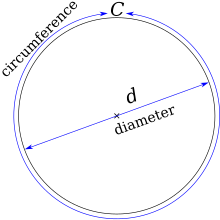
π is commonly defined as the ratio of a circle's circumference C to its diameter d:[10]

The ratio 


Here, the circumference of a circle is the
 , as the integral:[12]
, as the integral:[12]

An integral such as this was adopted as the definition of π by Karl Weierstrass, who defined it directly as an integral in 1841.[b]
Integration is no longer commonly used in a first analytical definition because, as
In a similar spirit, π can be defined using properties of the

A variation on the same idea, making use of sophisticated mathematical concepts of
Irrationality and normality
π is an
The digits of π have no apparent pattern and have passed tests for statistical randomness, including tests for normality; a number of infinite length is called normal when all possible sequences of digits (of any given length) appear equally often. The conjecture that π is normal has not been proven or disproven.[22]
Since the advent of computers, a large number of digits of π have been available on which to perform statistical analysis.
Transcendence
In addition to being irrational, π is also a
 .[25][c]
.[25][c]
The transcendence of π has two important consequences: First, π cannot be expressed using any finite combination of rational numbers and square roots or n-th roots (such as ![{\displaystyle {\sqrt[{3}]{31}}}](https://wikimedia.org/api/rest_v1/media/math/render/svg/1fb1cd8b2742403364f3adca4fc8b8ca4a21e7f5)

Continued fractions
As an irrational number, π cannot be represented as a

Truncating the continued fraction at any point yields a rational approximation for π; the first four of these are 3, 22/7, 333/106, and 355/113. These numbers are among the best-known and most widely used historical approximations of the constant. Each approximation generated in this way is a best rational approximation; that is, each is closer to π than any other fraction with the same or a smaller denominator.

The middle of these is due to the mid-17th century mathematician William Brouncker, see § Brouncker's formula.
Approximate value and digits
Some approximations of pi include:
- Integers: 3
- Fractions: Approximate fractions include (in order of increasing accuracy) 22/7, 333/106, 355/113, 52163/16604, 103993/33102, 104348/33215, and 245850922/78256779.[30] (List is selected terms from OEIS: A063674 and OEIS: A063673.)
- Digits: The first 50 decimal digits are 3.14159265358979323846264338327950288419716939937510...[34] (see OEIS: A000796)
Digits in other number systems
- The first 48 binary (base 2) digits (called bits) are 11.001001000011111101101010100010001000010110100011... (see OEIS: A004601)
- The first 38 digits in ternary (base 3) are 10.0102110122220102110021111102212222201... (see OEIS: A004602)
- The first 20 digits in hexadecimal (base 16) are 3.243F6A8885A308D31319...[35] (see OEIS: A062964)
- The first five sexagesimal (base 60) digits are 3;8,29,44,0,47[36] (see OEIS: A060707)
Complex numbers and Euler's identity

Any complex number, say z, can be expressed using a pair of real numbers. In the polar coordinate system, one number (radius or r) is used to represent z's distance from the origin of the complex plane, and the other (angle or φ) the counter-clockwise rotation from the positive real line:[37]

 . The frequent appearance of π in complex analysis can be related to the behaviour of the exponential function of a complex variable, described by Euler's formula:[38]
. The frequent appearance of π in complex analysis can be related to the behaviour of the exponential function of a complex variable, described by Euler's formula:[38]

 in Euler's formula results in Euler's identity, celebrated in mathematics due to it containing five important mathematical constants:[38][39]
in Euler's formula results in Euler's identity, celebrated in mathematics due to it containing five important mathematical constants:[38][39]

There are n different complex numbers z satisfying 

History
Antiquity
The best-known approximations to π dating before the Common Era were accurate to two decimal places; this was improved upon in Chinese mathematics in particular by the mid-first millennium, to an accuracy of seven decimal places. After this, no further progress was made until the late medieval period.
The earliest written approximations of π are found in
 .[32][41] Although some pyramidologists have theorized that the Great Pyramid of Giza was built with proportions related to π, this theory is not widely accepted by scholars.[42]
In the Shulba Sutras of Indian mathematics, dating to an oral tradition from the first or second millennium BC, approximations are given which have been variously interpreted as approximately 3.08831, 3.08833, 3.004, 3, or 3.125.[43]
.[32][41] Although some pyramidologists have theorized that the Great Pyramid of Giza was built with proportions related to π, this theory is not widely accepted by scholars.[42]
In the Shulba Sutras of Indian mathematics, dating to an oral tradition from the first or second millennium BC, approximations are given which have been variously interpreted as approximately 3.08831, 3.08833, 3.004, 3, or 3.125.[43]
Polygon approximation era


The first recorded algorithm for rigorously calculating the value of π was a geometrical approach using polygons, devised around 250 BC by the Greek mathematician Archimedes, implementing the method of exhaustion.[44] This polygonal algorithm dominated for over 1,000 years, and as a result π is sometimes referred to as Archimedes's constant.[45] Archimedes computed upper and lower bounds of π by drawing a regular hexagon inside and outside a circle, and successively doubling the number of sides until he reached a 96-sided regular polygon. By calculating the perimeters of these polygons, he proved that 223/71 < π < 22/7 (that is, 3.1408 < π < 3.1429).[46] Archimedes' upper bound of 22/7 may have led to a widespread popular belief that π is equal to 22/7.[47] Around 150 AD, Greek-Roman scientist Ptolemy, in his Almagest, gave a value for π of 3.1416, which he may have obtained from Archimedes or from Apollonius of Perga.[48][49] Mathematicians using polygonal algorithms reached 39 digits of π in 1630, a record only broken in 1699 when infinite series were used to reach 71 digits.[50]
In
 (100 AD, approximately 3.1623), and 142/45 (3rd century, approximately 3.1556).[51] Around 265 AD, the Wei Kingdom mathematician Liu Hui created a polygon-based iterative algorithm and used it with a 3,072-sided polygon to obtain a value of π of 3.1416.[52][53] Liu later invented a faster method of calculating π and obtained a value of 3.14 with a 96-sided polygon, by taking advantage of the fact that the differences in area of successive polygons form a geometric series with a factor of 4.[52] The Chinese mathematician Zu Chongzhi, around 480 AD, calculated that
(100 AD, approximately 3.1623), and 142/45 (3rd century, approximately 3.1556).[51] Around 265 AD, the Wei Kingdom mathematician Liu Hui created a polygon-based iterative algorithm and used it with a 3,072-sided polygon to obtain a value of π of 3.1416.[52][53] Liu later invented a faster method of calculating π and obtained a value of 3.14 with a 96-sided polygon, by taking advantage of the fact that the differences in area of successive polygons form a geometric series with a factor of 4.[52] The Chinese mathematician Zu Chongzhi, around 480 AD, calculated that  and suggested the approximations
and suggested the approximations  and
and  , which he termed the Milü (''close ratio") and Yuelü ("approximate ratio"), respectively, using Liu Hui's algorithm applied to a 12,288-sided polygon. With a correct value for its seven first decimal digits, this value remained the most accurate approximation of π available for the next 800 years.[54]
, which he termed the Milü (''close ratio") and Yuelü ("approximate ratio"), respectively, using Liu Hui's algorithm applied to a 12,288-sided polygon. With a correct value for its seven first decimal digits, this value remained the most accurate approximation of π available for the next 800 years.[54]
The Indian astronomer
 .[56]
.[56]
The Persian astronomer
 sides,[57][58] which stood as the world record for about 180 years.[59] French mathematician François Viète in 1579 achieved nine digits with a polygon of
sides,[57][58] which stood as the world record for about 180 years.[59] French mathematician François Viète in 1579 achieved nine digits with a polygon of  sides.[59] Flemish mathematician Adriaan van Roomen arrived at 15 decimal places in 1593.[59] In 1596, Dutch mathematician Ludolph van Ceulen reached 20 digits, a record he later increased to 35 digits (as a result, π was called the "Ludolphian number" in Germany until the early 20th century).[60] Dutch scientist Willebrord Snellius reached 34 digits in 1621,[61] and Austrian astronomer Christoph Grienberger arrived at 38 digits in 1630 using 1040 sides.[62] Christiaan Huygens was able to arrive at 10 decimal places in 1654 using a slightly different method equivalent to Richardson extrapolation.[63][64]
sides.[59] Flemish mathematician Adriaan van Roomen arrived at 15 decimal places in 1593.[59] In 1596, Dutch mathematician Ludolph van Ceulen reached 20 digits, a record he later increased to 35 digits (as a result, π was called the "Ludolphian number" in Germany until the early 20th century).[60] Dutch scientist Willebrord Snellius reached 34 digits in 1621,[61] and Austrian astronomer Christoph Grienberger arrived at 38 digits in 1630 using 1040 sides.[62] Christiaan Huygens was able to arrive at 10 decimal places in 1654 using a slightly different method equivalent to Richardson extrapolation.[63][64]
Infinite series

The calculation of π was revolutionized by the development of
In 1593,

In 1655, John Wallis published what is now known as Wallis product, also an infinite product:[69]

In the 1660s, the English scientist Isaac Newton and German mathematician Gottfried Wilhelm Leibniz discovered calculus, which led to the development of many infinite series for approximating π. Newton himself used an arcsine series to compute a 15-digit approximation of π in 1665 or 1666, writing, "I am ashamed to tell you to how many figures I carried these computations, having no other business at the time."[72]
In 1671,

This series, sometimes called the
 when evaluated with
when evaluated with  .[74] But for
.[74] But for  , it converges impractically slowly (that is, approaches the answer very gradually), taking about ten times as many terms to calculate each additional digit.[75]
, it converges impractically slowly (that is, approaches the answer very gradually), taking about ten times as many terms to calculate each additional digit.[75]
In 1699, English mathematician Abraham Sharp used the Gregory–Leibniz series for 
In 1706, John Machin used the Gregory–Leibniz series to produce an algorithm that converged much faster:[3][77][78]

Machin reached 100 digits of π with this formula.[79] Other mathematicians created variants, now known as Machin-like formulae, that were used to set several successive records for calculating digits of π.[80][79]
Isaac Newton accelerated the convergence of the Gregory–Leibniz series in 1684 (in an unpublished work; others independently discovered the result):[81]
Leonhard Euler popularized this series in his 1755 differential calculus textbook, and later used it with Machin-like formulae, including 
Machin-like formulae remained the best-known method for calculating π well into the age of computers, and were used to set records for 250 years, culminating in a 620-digit approximation in 1946 by Daniel Ferguson – the best approximation achieved without the aid of a calculating device.[83]
In 1844, a record was set by Zacharias Dase, who employed a Machin-like formula to calculate 200 decimals of π in his head at the behest of German mathematician Carl Friedrich Gauss.[84]
In 1853, British mathematician William Shanks calculated π to 607 digits, but made a mistake in the 528th digit, rendering all subsequent digits incorrect. Though he calculated an additional 100 digits in 1873, bringing the total up to 707, his previous mistake rendered all the new digits incorrect as well.[85]
Rate of convergence
Some infinite series for π converge faster than others. Given the choice of two infinite series for π, mathematicians will generally use the one that converges more rapidly because faster convergence reduces the amount of computation needed to calculate π to any given accuracy.[86] A simple infinite series for π is the Gregory–Leibniz series:[87]

As individual terms of this infinite series are added to the sum, the total gradually gets closer to π, and – with a sufficient number of terms – can get as close to π as desired. It converges quite slowly, though – after 500,000 terms, it produces only five correct decimal digits of π.[88]
An infinite series for π (published by Nilakantha in the 15th century) that converges more rapidly than the Gregory–Leibniz series is:[89][90]

The following table compares the convergence rates of these two series:
| Infinite series for π | After 1st term | After 2nd term | After 3rd term | After 4th term | After 5th term | Converges to: |
|---|---|---|---|---|---|---|

|
4.0000 | 2.6666 ... | 3.4666 ... | 2.8952 ... | 3.3396 ... | π = 3.1415 ... |

|
3.0000 | 3.1666 ... | 3.1333 ... | 3.1452 ... | 3.1396 ... |
After five terms, the sum of the Gregory–Leibniz series is within 0.2 of the correct value of π, whereas the sum of Nilakantha's series is within 0.002 of the correct value. Nilakantha's series converges faster and is more useful for computing digits of π. Series that converge even faster include Machin's series and Chudnovsky's series, the latter producing 14 correct decimal digits per term.[86]
Irrationality and transcendence
Not all mathematical advances relating to π were aimed at increasing the accuracy of approximations. When Euler solved the Basel problem in 1735, finding the exact value of the sum of the reciprocal squares, he established a connection between π and the prime numbers that later contributed to the development and study of the Riemann zeta function:[91]

Swiss scientist Johann Heinrich Lambert in 1768 proved that π is irrational, meaning it is not equal to the quotient of any two integers.[20] Lambert's proof exploited a continued-fraction representation of the tangent function.[92] French mathematician Adrien-Marie Legendre proved in 1794 that π2 is also irrational. In 1882, German mathematician Ferdinand von Lindemann proved that π is transcendental,[93] confirming a conjecture made by both Legendre and Euler.[94][95] Hardy and Wright states that "the proofs were afterwards modified and simplified by Hilbert, Hurwitz, and other writers".[96]
Adoption of the symbol π
In the earliest usages, the Greek letter π was used to denote the semiperimeter (semiperipheria in Latin) of a circle[8] and was combined in ratios with δ (for diameter or semidiameter) or ρ (for radius) to form circle constants.[97][98][99][100] (Before then, mathematicians sometimes used letters such as c or p instead.[101]) The first recorded use is Oughtred's "


The earliest known use of the Greek letter π alone to represent the ratio of a circle's circumference to its diameter was by Welsh mathematician William Jones in his 1706 work Synopsis Palmariorum Matheseos; or, a New Introduction to the Mathematics.[3][105] The Greek letter appears on p. 243 in the phrase "
Modern quest for more digits
Computer era and iterative algorithms
The Gauss–Legendre iterative algorithm:
InitializeIterateThen an estimate for π is given by
The development of computers in the mid-20th century again revolutionized the hunt for digits of π. Mathematicians
Two additional developments around 1980 once again accelerated the ability to compute π. First, the discovery of new
The iterative algorithms were independently published in 1975–1976 by physicist
The iterative algorithms were widely used after 1980 because they are faster than infinite series algorithms: whereas infinite series typically increase the number of correct digits additively in successive terms, iterative algorithms generally multiply the number of correct digits at each step. For example, the Brent–Salamin algorithm doubles the number of digits in each iteration. In 1984, brothers John and Peter Borwein produced an iterative algorithm that quadruples the number of digits in each step; and in 1987, one that increases the number of digits five times in each step.[120] Iterative methods were used by Japanese mathematician Yasumasa Kanada to set several records for computing π between 1995 and 2002.[121] This rapid convergence comes at a price: the iterative algorithms require significantly more memory than infinite series.[121]
Motives for computing π

For most numerical calculations involving π, a handful of digits provide sufficient precision. According to Jörg Arndt and Christoph Haenel, thirty-nine digits are sufficient to perform most
Rapidly convergent series

Modern π calculators do not use iterative algorithms exclusively. New infinite series were discovered in the 1980s and 1990s that are as fast as iterative algorithms, yet are simpler and less memory intensive.[121] The fast iterative algorithms were anticipated in 1914, when Indian mathematician Srinivasa Ramanujan published dozens of innovative new formulae for π, remarkable for their elegance, mathematical depth and rapid convergence.[126] One of his formulae, based on modular equations, is

This series converges much more rapidly than most arctan series, including Machin's formula.[127] Bill Gosper was the first to use it for advances in the calculation of π, setting a record of 17 million digits in 1985.[128] Ramanujan's formulae anticipated the modern algorithms developed by the Borwein brothers (Jonathan and Peter) and the Chudnovsky brothers.[129] The Chudnovsky formula developed in 1987 is

It produces about 14 digits of π per term[130] and has been used for several record-setting π calculations, including the first to surpass 1 billion (109) digits in 1989 by the Chudnovsky brothers, 10 trillion (1013) digits in 2011 by Alexander Yee and Shigeru Kondo,[131] and 100 trillion digits by Emma Haruka Iwao in 2022.[132] For similar formulae, see also the Ramanujan–Sato series.
In 2006, mathematician Simon Plouffe used the PSLQ integer relation algorithm[133] to generate several new formulae for π, conforming to the following template:

Monte Carlo methods

Another Monte Carlo method for computing π is to draw a circle inscribed in a square, and randomly place dots in the square. The ratio of dots inside the circle to the total number of dots will approximately equal π/4.[137]

Another way to calculate π using probability is to start with a random walk, generated by a sequence of (fair) coin tosses: independent random variables Xk such that Xk ∈ {−1,1} with equal probabilities. The associated random walk is

![{\displaystyle \pi =\lim _{n\to \infty }{\frac {2n}{E[|W_{n}|]^{2}}}.}](https://wikimedia.org/api/rest_v1/media/math/render/svg/a691be63815c6b7d9fe15070ae98039d9c1d0384)
This Monte Carlo method is independent of any relation to circles, and is a consequence of the central limit theorem, discussed below.
These Monte Carlo methods for approximating π are very slow compared to other methods, and do not provide any information on the exact number of digits that are obtained. Thus they are never used to approximate π when speed or accuracy is desired.[139]
Spigot algorithms
Two algorithms were discovered in 1995 that opened up new avenues of research into π. They are called spigot algorithms because, like water dripping from a spigot, they produce single digits of π that are not reused after they are calculated.[140][141] This is in contrast to infinite series or iterative algorithms, which retain and use all intermediate digits until the final result is produced.[140]
Mathematicians Stan Wagon and Stanley Rabinowitz produced a simple spigot algorithm in 1995.[141][142][143] Its speed is comparable to arctan algorithms, but not as fast as iterative algorithms.[142]
Another spigot algorithm, the

This formula, unlike others before it, can produce any individual hexadecimal digit of π without calculating all the preceding digits.[144] Individual binary digits may be extracted from individual hexadecimal digits, and octal digits can be extracted from one or two hexadecimal digits. An important application of digit extraction algorithms is to validate new claims of record π computations: After a new record is claimed, the decimal result is converted to hexadecimal, and then a digit extraction algorithm is used to calculate several randomly selected hexadecimal digits near the end; if they match, this provides a measure of confidence that the entire computation is correct.[131]
Between 1998 and 2000, the distributed computing project PiHex used Bellard's formula (a modification of the BBP algorithm) to compute the quadrillionth (1015th) bit of π, which turned out to be 0.[146] In September 2010, a Yahoo! employee used the company's Hadoop application on one thousand computers over a 23-day period to compute 256 bits of π at the two-quadrillionth (2×1015th) bit, which also happens to be zero.[147]
In 2022, Plouffe found a base-10 algorithm for calculating digits of π.[148]
Role and characterizations in mathematics
Because π is closely related to the circle, it is found in many formulae from the fields of geometry and trigonometry, particularly those concerning circles, spheres, or ellipses. Other branches of science, such as statistics, physics, Fourier analysis, and number theory, also include π in some of their important formulae.
Geometry and trigonometry
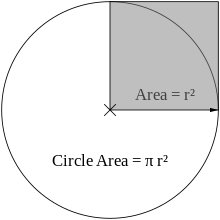
π appears in formulae for areas and volumes of geometrical shapes based on circles, such as
- The circumference of a circle with radius r is 2πr.
- The area of a circlewith radius r is πr2.
- The area of an ellipse with semi-major axis a and semi-minor axis b is πab.
- The volume of a sphere with radius r is 4/3πr3.
- The surface area of a sphere with radius r is 4πr2.
Some of the formulae above are special cases of the volume of the
Apart from circles, there are other curves of constant width. By Barbier's theorem, every curve of constant width has perimeter π times its width. The Reuleaux triangle (formed by the intersection of three circles with the sides of an equilateral triangle as their radii) has the smallest possible area for its width and the circle the largest. There also exist non-circular smooth and even algebraic curves of constant width.[150]
Definite integrals that describe circumference, area, or volume of shapes generated by circles typically have values that involve π. For example, an integral that specifies half the area of a circle of radius one is given by:[151]

In that integral, the function 

Units of angle
Common trigonometric functions have periods that are multiples of π; for example, sine and cosine have period 2π,[153] so for any angle θ and any integer k,[153]

Eigenvalues
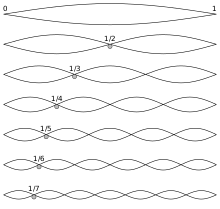
Many of the appearances of π in the formulae of mathematics and the sciences have to do with its close relationship with geometry. However, π also appears in many natural situations having apparently nothing to do with geometry.
In many applications, it plays a distinguished role as an
 , or
, or  . Thus λ is an eigenvalue of the second derivative operator
. Thus λ is an eigenvalue of the second derivative operator  , and is constrained by
, and is constrained by The value π is, in fact, the least such value of the wavenumber, and is associated with the
![{\displaystyle f:[0,1]\to \mathbb {C} }](https://wikimedia.org/api/rest_v1/media/math/render/svg/f0468f15485d405d64092878cda0fc0cbdab2f62) with f(0) = f(1) = 0 and f, f′ both
with f(0) = f(1) = 0 and f, f′ both 
![{\displaystyle H_{0}^{1}[0,1]}](https://wikimedia.org/api/rest_v1/media/math/render/svg/7113d194de39d54621e9da47782ad5263b9f1790) ).
).
Inequalities

The number π serves appears in similar eigenvalue problems in higher-dimensional analysis. As mentioned

Ultimately, as a consequence of the isoperimetric inequality, π appears in the optimal constant for the critical Sobolev inequality in n dimensions, which thus characterizes the role of π in many physical phenomena as well, for example those of classical potential theory.[158][159][160] In two dimensions, the critical Sobolev inequality is

 is the gradient of f, and
is the gradient of f, and  and
and  refer respectively to the L2 and L1-norm. The Sobolev inequality is equivalent to the isoperimetric inequality (in any dimension), with the same best constants.
refer respectively to the L2 and L1-norm. The Sobolev inequality is equivalent to the isoperimetric inequality (in any dimension), with the same best constants.
Wirtinger's inequality also generalizes to higher-dimensional Poincaré inequalities that provide best constants for the Dirichlet energy of an n-dimensional membrane. Specifically, π is the greatest constant such that

Fourier transform and Heisenberg uncertainty principle

The constant π also appears as a critical spectral parameter in the Fourier transform. This is the integral transform, that takes a complex-valued integrable function f on the real line to the function defined as:

Although there are several different conventions for the Fourier transform and its inverse, any such convention must involve π somewhere. The above is the most canonical definition, however, giving the unique unitary operator on L2 that is also an algebra homomorphism of L1 to L∞.[162]
The

The physical consequence, about the uncertainty in simultaneous position and momentum observations of a
Gaussian integrals

The fields of probability and statistics frequently use the normal distribution as a simple model for complex phenomena; for example, scientists generally assume that the observational error in most experiments follows a normal distribution.[164] The Gaussian function, which is the probability density function of the normal distribution with mean μ and standard deviation σ, naturally contains π:[165]

The factor of 

The central limit theorem explains the central role of normal distributions, and thus of π, in probability and statistics. This theorem is ultimately connected with the spectral characterization of π as the eigenvalue associated with the Heisenberg uncertainty principle, and the fact that equality holds in the uncertainty principle only for the Gaussian function.[166] Equivalently, π is the unique constant making the Gaussian normal distribution e−πx2 equal to its own Fourier transform.[167] Indeed, according to Howe (1980), the "whole business" of establishing the fundamental theorems of Fourier analysis reduces to the Gaussian integral.[163]
Topology
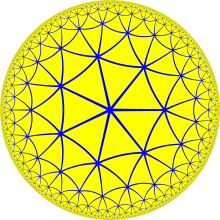
The constant π appears in the


The constant appears in many other integral formulae in topology, in particular, those involving characteristic classes via the Chern–Weil homomorphism.[169]
Cauchy's integral formula

One of the key tools in

Although the curve γ is not a circle, and hence does not have any obvious connection to the constant π, a standard proof of this result uses Morera's theorem, which implies that the integral is invariant under homotopy of the curve, so that it can be deformed to a circle and then integrated explicitly in polar coordinates. More generally, it is true that if a rectifiable closed curve γ does not contain z0, then the above integral is 2πi times the winding number of the curve.
The general form of Cauchy's integral formula establishes the relationship between the values of a


Vector calculus and physics
The constant π is ubiquitous in

 is necessary to ensure that
is necessary to ensure that  is the
is the  :[175]
:[175]

 is the Dirac delta function.
is the Dirac delta function.
In higher dimensions, factors of π are present because of a normalization by the n-dimensional volume of the unit

Total curvature

In
The gamma function and Stirling's approximation

The factorial function 



The gamma function is defined by its

The gamma function is used to calculate the volume Vn(r) of the


Further, it follows from the functional equation that

The gamma function can be used to create a simple approximation to the factorial function n! for large n: 

As a geometrical application of Stirling's approximation, let Δn denote the standard simplex in n-dimensional Euclidean space, and (n + 1)Δn denote the simplex having all of its sides scaled up by a factor of n + 1. Then

Number theory and Riemann zeta function

The Riemann zeta function ζ(s) is used in many areas of mathematics. When evaluated at s = 2 it can be written as

Finding a
![{\displaystyle {\begin{aligned}\prod _{p}^{\infty }\left(1-{\frac {1}{p^{2}}}\right)&=\left(\prod _{p}^{\infty }{\frac {1}{1-p^{-2}}}\right)^{-1}\\[4pt]&={\frac {1}{1+{\frac {1}{2^{2}}}+{\frac {1}{3^{2}}}+\cdots }}\\[4pt]&={\frac {1}{\zeta (2)}}={\frac {6}{\pi ^{2}}}\approx 61\%.\end{aligned}}}](https://wikimedia.org/api/rest_v1/media/math/render/svg/33ad11b6609d91487577949c7a42872afdc33a36)
This probability can be used in conjunction with a
The solution to the Basel problem implies that the geometrically derived quantity π is connected in a deep way to the distribution of prime numbers. This is a special case of
The zeta function also satisfies Riemann's functional equation, which involves π as well as the gamma function:

Furthermore, the derivative of the zeta function satisfies

A consequence is that π can be obtained from the functional determinant of the harmonic oscillator. This functional determinant can be computed via a product expansion, and is equivalent to the Wallis product formula.[186] The calculation can be recast in quantum mechanics, specifically the variational approach to the spectrum of the hydrogen atom.[187]
Fourier series
The constant π also appears naturally in
U(1) of unit modulus complex numbers. It is a theorem that every character of T is one of the complex exponentials .
.
There is a unique character on T, up to complex conjugation, that is a group isomorphism. Using the
Modular forms and theta functions
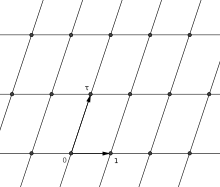
The constant π is connected in a deep way with the theory of modular forms and theta functions. For example, the Chudnovsky algorithm involves in an essential way the j-invariant of an elliptic curve.
 (or its various subgroups), a lattice in the group
(or its various subgroups), a lattice in the group  . An example is the
. An example is the 
 .
.
The constant π is the unique constant making the Jacobi theta function an automorphic form, which means that it transforms in a specific way. Certain identities hold for all automorphic forms. An example is

Cauchy distribution and potential theory
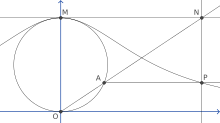



The
The Cauchy distribution plays an important role in

The constant π is the unique (positive) normalizing factor such that H defines a linear complex structure on the Hilbert space of square-integrable real-valued functions on the real line.[192] The Hilbert transform, like the Fourier transform, can be characterized purely in terms of its transformation properties on the Hilbert space L2(R): up to a normalization factor, it is the unique bounded linear operator that commutes with positive dilations and anti-commutes with all reflections of the real line.[193] The constant π is the unique normalizing factor that makes this transformation unitary.
In the Mandelbrot set

An occurrence of π in the fractal called the Mandelbrot set was discovered by David Boll in 1991.[194] He examined the behaviour of the Mandelbrot set near the "neck" at (−0.75, 0). When the number of iterations until divergence for the point (−0.75, ε) is multiplied by ε, the result approaches π as ε approaches zero. The point (0.25 + ε, 0) at the cusp of the large "valley" on the right side of the Mandelbrot set behaves similarly: the number of iterations until divergence multiplied by the square root of ε tends to π.[194][195]
Projective geometry
Let V be the set of all twice differentiable real functions 

 , let
, let  be the evaluation functional, which associates to each
be the evaluation functional, which associates to each  the value
the value  of the function f at the real point t. Then, for each t, the
of the function f at the real point t. Then, for each t, the  is a one-dimensional linear subspace of V. Hence
is a one-dimensional linear subspace of V. Hence  defines a function from
defines a function from  from the real line to the real projective line. This function is periodic, and the quantity π can be characterized as the period of this map.[196] This is notable in that the constant π, rather than 2π, appears naturally in this context.
from the real line to the real projective line. This function is periodic, and the quantity π can be characterized as the period of this map.[196] This is notable in that the constant π, rather than 2π, appears naturally in this context.
Outside mathematics
Describing physical phenomena
Although not a physical constant, π appears routinely in equations describing fundamental principles of the universe, often because of π's relationship to the circle and to spherical coordinate systems. A simple formula from the field of classical mechanics gives the approximate period T of a simple pendulum of length L, swinging with a small amplitude (g is the earth's gravitational acceleration):[197]

One of the key formulae of

The fact that π is approximately equal to 3 plays a role in the relatively long lifetime of

π is present in some structural engineering formulae, such as the

The field of

In electromagnetics, the vacuum permeability constant μ0 appears in Maxwell's equations, which describe the properties of electric and magnetic fields and electromagnetic radiation. Before 20 May 2019, it was defined as exactly

Memorizing digits
Piphilology is the practice of memorizing large numbers of digits of π,[202] and world-records are kept by the Guinness World Records. The record for memorizing digits of π, certified by Guinness World Records, is 70,000 digits, recited in India by Rajveer Meena in 9 hours and 27 minutes on 21 March 2015.[203] In 2006, Akira Haraguchi, a retired Japanese engineer, claimed to have recited 100,000 decimal places, but the claim was not verified by Guinness World Records.[204]
One common technique is to memorize a story or poem in which the word lengths represent the digits of π: The first word has three letters, the second word has one, the third has four, the fourth has one, the fifth has five, and so on. Such memorization aids are called
A few authors have used the digits of π to establish a new form of constrained writing, where the word lengths are required to represent the digits of π. The Cadaeic Cadenza contains the first 3835 digits of π in this manner,[207] and the full-length book Not a Wake contains 10,000 words, each representing one digit of π.[208]
In popular culture
Perhaps because of the simplicity of its definition and its ubiquitous presence in formulae, π has been represented in popular culture more than other mathematical constructs.[209]
In the Palais de la Découverte (a science museum in Paris) there is a circular room known as the pi room. On its wall are inscribed 707 digits of π. The digits are large wooden characters attached to the dome-like ceiling. The digits were based on an 1873 calculation by English mathematician William Shanks, which included an error beginning at the 528th digit. The error was detected in 1946 and corrected in 1949.[210]
In Carl Sagan's 1985 novel Contact it is suggested that the creator of the universe buried a message deep within the digits of π. This part of the story was omitted from the film adaptation of the novel.[211][212] The digits of π have also been incorporated into the lyrics of the song "Pi" from the 2005 album Aerial by Kate Bush.[213] In the 1967 Star Trek episode "Wolf in the Fold", an out-of-control computer is contained by being instructed to "Compute to the last digit the value of π".[46]
In the United States,
Some have proposed replacing π by
In 1897, an amateur mathematician attempted to persuade the
In computer culture
In contemporary internet culture, individuals and organizations frequently pay homage to the number π. For instance, the computer scientist Donald Knuth let the version numbers of his program TeX approach π. The versions are 3, 3.1, 3.14, and so forth.[225] τ has been added to several programming languages as a predefined constant.[226][227]
See also
References
Explanatory notes
- ^ In particular, π is conjectured to be a normal number, which implies a specific kind of statistical randomness on its digits in all bases.
- ^ The precise integral that Weierstrass used was
Remmert 2012, p. 148
- sinefunction.
Citations
- ^ Andrews, Askey & Roy 1999, p. 59.
- ^ Gupta, R. C. (1992). "On the remainder term in the Madhava–Leibniz's series". Ganita Bharati. 14 (1–4): 68–71.
- ^ a b c Jones, William (1706). Synopsis Palmariorum Matheseos. London: J. Wale. pp. 243, 263. p. 263:
There are various other ways of finding the Lengths, or Areas of particular Curve Lines or Planes, which may very much facilitate the Practice; as for instance, in the Circle, the Diameter is to Circumference as 1 to
3.14159, &c. = π. This Series (among others for the same purpose, and drawn from the same Principle) I receiv'd from the Excellent Analyst, and my much Esteem'd Friend Mr. John Machin; and by means thereof, Van Ceulen's Number, or that in Art. 64.38. may be Examin'd with all desireable Ease and Dispatch.Reprinted in Smith, David Eugene (1929). "William Jones: The First Use of π for the Circle Ratio". A Source Book in Mathematics. McGraw–Hill. pp. 346–347.
- ^ "πe trillion digits of π". pi2e.ch. Archived from the original on 6 December 2016.
- ^ Haruka Iwao, Emma (14 March 2019). "Pi in the sky: Calculating a record-breaking 31.4 trillion digits of Archimedes' constant on Google Cloud". Google Cloud Platform. Archived from the original on 19 October 2019. Retrieved 12 April 2019.
- ^ Arndt & Haenel 2006, p. 17.
- S2CID 14318695.
- ^ a b Oughtred, William (1652). Theorematum in libris Archimedis de sphaera et cylindro declarario (in Latin). Excudebat L. Lichfield, Veneunt apud T. Robinson.
δ.π :: semidiameter. semiperipheria
- ^ "pi". Dictionary.reference.com. 2 March 1993. Archived from the original on 28 July 2014. Retrieved 18 June 2012.
- ^ a b c Arndt & Haenel 2006, p. 8.
- ^ Apostol, Tom (1967). Calculus. Vol. 1 (2nd ed.). Wiley. p. 102.
From a logical point of view, this is unsatisfactory at the present stage because we have not yet discussed the concept of arc length
- ^ a b c Remmert 2012, p. 129.
- ^ Baltzer, Richard (1870). Die Elemente der Mathematik [The Elements of Mathematics] (in German). Hirzel. p. 195. Archived from the original on 14 September 2016.
- ^ Landau, Edmund (1934). Einführung in die Differentialrechnung und Integralrechnung (in German). Noordoff. p. 193.
- ^ ISBN 978-0-07-054235-8.
- ^ Rudin, Walter (1986). Real and complex analysis. McGraw-Hill. p. 2.
- ^ Ahlfors, Lars (1966). Complex analysis. McGraw-Hill. p. 46.
- ^ Bourbaki, Nicolas (1981). Topologie generale. Springer. §VIII.2.
- ^ a b Bourbaki, Nicolas (1979). Fonctions d'une variable réelle (in French). Springer. §II.3.
- ^ a b Arndt & Haenel 2006, p. 5.
- S2CID 250798202.
- ^ Arndt & Haenel 2006, pp. 22–23.
- ^ Arndt & Haenel 2006, pp. 22, 28–30.
- ^ Arndt & Haenel 2006, p. 3.
- ^ Arndt & Haenel 2006, p. 6.
- ^ Posamentier & Lehmann 2004, p. 25
- ^ Eymard & Lafon 2004, p. 129
- ISBN 978-0-88029-418-8.
- ISBN 978-0-7876-3933-4. Archivedfrom the original on 13 December 2019. Retrieved 19 December 2019., p. 185.
- ^ a b Eymard & Lafon 2004, p. 78
- ^ Arndt & Haenel 2006, p. 33.
- ^ MR 1743850.
- JSTOR 2589152.
- ^ Arndt & Haenel 2006, p. 240.
- ^ Arndt & Haenel 2006, p. 242.
- ISBN 978-0-88385-613-0. Archivedfrom the original on 29 November 2016.
- ^ Abramson 2014, Section 8.5: Polar form of complex numbers.
- ^ a b Bronshteĭn & Semendiaev 1971, p. 592
- ISBN 978-0-691-14134-3.
- ^ Andrews, Askey & Roy 1999, p. 14.
- ^ a b Arndt & Haenel 2006, p. 167.
- ISBN 978-0-88920-324-2. Archivedfrom the original on 29 November 2016. Retrieved 5 June 2013.
- ISBN 978-0691120676.
- ^ Arndt & Haenel 2006, p. 170.
- ^ Arndt & Haenel 2006, pp. 175, 205.
- ^ MR 3203895.
- ^ Arndt & Haenel 2006, p. 171.
- ^ Arndt & Haenel 2006, p. 176.
- ^ Boyer & Merzbach 1991, p. 168.
- ^ Arndt & Haenel 2006, pp. 15–16, 175, 184–186, 205. Grienberger achieved 39 digits in 1630; Sharp 71 digits in 1699.
- ^ Arndt & Haenel 2006, pp. 176–177.
- ^ a b Boyer & Merzbach 1991, p. 202
- ^ Arndt & Haenel 2006, p. 177.
- ^ Arndt & Haenel 2006, p. 178.
- ^ Arndt & Haenel 2006, p. 179.
- ^ a b Arndt & Haenel 2006, p. 180.
- .
- MacTutor History of Mathematics archive. Archivedfrom the original on 12 April 2011. Retrieved 11 August 2012.
- ^ a b c Arndt & Haenel 2006, p. 182.
- ^ Arndt & Haenel 2006, pp. 182–183.
- ^ Arndt & Haenel 2006, p. 183.
- ^ Grienbergerus, Christophorus (1630). Elementa Trigonometrica (PDF) (in Latin). Archived from the original (PDF) on 1 February 2014. His evaluation was 3.14159 26535 89793 23846 26433 83279 50288 4196 < π < 3.14159 26535 89793 23846 26433 83279 50288 4199.
- ISBN 978-981-283-625-0.
- ^ Yoder, Joella G. (1996). "Following in the footsteps of geometry: The mathematical world of Christiaan Huygens". De Zeventiende Eeuw. 12: 83–93 – via Digital Library for Dutch Literature.
- ^ Arndt & Haenel 2006, pp. 185–191
- ^ .
- ^ Arndt & Haenel 2006, pp. 185–186.
- ISBN 978-0-691-13526-7.
- ^ a b Arndt & Haenel 2006, p. 187.
- ^ OEIS: A060294
- ^ Vieta, Franciscus (1593). Variorum de rebus mathematicis responsorum. Vol. VIII.
- ^ a b Arndt & Haenel 2006, p. 188. Newton quoted by Arndt.
- ^ Horvath, Miklos (1983). "On the Leibnizian quadrature of the circle" (PDF). Annales Universitatis Scientiarum Budapestiensis (Sectio Computatorica). 4: 75–83.
- ^ a b Eymard & Lafon 2004, pp. 53–54
- S2CID 123392772. Archived from the original on 4 May 2019. Retrieved 23 February 2023.)
{{cite journal}}: CS1 maint: bot: original URL status unknown (link - ^ Arndt & Haenel 2006, p. 189.
- S2CID 121087222.
- ^ Arndt & Haenel 2006, pp. 192–193.
- ^ a b Arndt & Haenel 2006, pp. 72–74
- JSTOR 2302434.
- ^ Roy, Ranjan (2021) [1st ed. 2011]. Series and Products in the Development of Mathematics. Vol. 1 (2 ed.). Cambridge University Press. pp. 215–216, 219–220.
Newton, Isaac (1971). Whiteside, Derek Thomas (ed.). The Mathematical Papers of Isaac Newton. Vol. 4, 1674–1684. Cambridge University Press. pp. 526–653.
- ^
Sandifer, Ed (2009). "Estimating π" (PDF). How Euler Did It. Reprinted in How Euler Did Even More. Mathematical Association of America. 2014. pp. 109–118.
Euler, Leonhard (1755). "§2.2.30". Institutiones Calculi Differentialis (in Latin). Academiae Imperialis Scientiarium Petropolitanae. p. 318. E 212.
Euler, Leonhard (1798) [written 1779]. "Investigatio quarundam serierum, quae ad rationem peripheriae circuli ad diametrum vero proxime definiendam maxime sunt accommodatae". Nova Acta Academiae Scientiarum Petropolitinae. 11: 133–149, 167–168. E 705.
Chien-Lih, Hwang (2004). "88.38 Some Observations on the Method of Arctangents for the Calculation of π". Mathematical Gazette. 88 (512): 270–278.
S2CID 123532808.Chien-Lih, Hwang (2005). "89.67 An elementary derivation of Euler's series for the arctangent function". Mathematical Gazette. 89 (516): 469–470.
S2CID 123395287. - ^ Arndt & Haenel 2006, pp. 192–196, 205.
- ^ Arndt & Haenel 2006, pp. 194–196
- . Retrieved 22 January 2022.
- ^ , pp. 15–17, 70–72, 104, 156, 192–197, 201–202
- ^ Arndt & Haenel 2006, pp. 69–72.
- JSTOR 2324715.
- ^ Arndt & Haenel 2006, Formula 16.10, p. 223.
- ISBN 978-0-14-026149-3.
- ^ a b Posamentier & Lehmann 2004, p. 284
- ^ Lambert, Johann, "Mémoire sur quelques propriétés remarquables des quantités transcendantes circulaires et logarithmiques", reprinted in Berggren, Borwein & Borwein 1997, pp. 129–140
- Lindemann, F. (1882). "Über die Ludolph'sche Zahl". Sitzungsberichte der Königlich Preussischen Akademie der Wissenschaften zu Berlin. 2: 679–682.
- ^ Arndt & Haenel 2006, p. 196.
- ^ Hardy and Wright 1938 and 2000: 177 footnote § 11.13–14 references Lindemann's proof as appearing at Math. Ann. 20 (1882), 213–225.
- ^ cf Hardy and Wright 1938 and 2000:177 footnote § 11.13–14. The proofs that e and π are transcendental can be found on pp. 170–176. They cite two sources of the proofs at Landau 1927 or Perron 1910; see the "List of Books" at pp. 417–419 for full citations.
- ^ ISBN 978-1-60206-714-1.
the ratio of the length of a circle to its diameter was represented in the fractional form by the use of two letters ... J.A. Segner ... in 1767, he represented 3.14159... by δ:π, as did Oughtred more than a century earlier
- used the letter π to represent the periphery (that is, the circumference) of a circle.
- ^ ISBN 978-0-486-20430-7.
- JSTOR 2972388.
It is noticeable that these letters are never used separately, that is, π is not used for 'Semiperipheria'
- ^ a b c d Arndt & Haenel 2006, p. 166.
- ^ See, for example, Oughtred, William (1648). Clavis Mathematicæ [The key to mathematics] (in Latin). London: Thomas Harper. p. 69. (English translation: Oughtred, William (1694). Key of the Mathematics. J. Salusbury.)
- ^ Barrow, Isaac (1860). "Lecture XXIV". In Whewell, William (ed.). The mathematical works of Isaac Barrow (in Latin). Harvard University. Cambridge University press. p. 381.
- JSTOR 102382.
- ^ Arndt & Haenel 2006, p. 165: A facsimile of Jones' text is in Berggren, Borwein & Borwein 1997, pp. 108–109.
- ^ Segner, Joannes Andreas (1756). Cursus Mathematicus (in Latin). Halae Magdeburgicae. p. 282. Archived from the original on 15 October 2017. Retrieved 15 October 2017.
- ^ Euler, Leonhard (1727). "Tentamen explicationis phaenomenorum aeris" (PDF). Commentarii Academiae Scientiarum Imperialis Petropolitana (in Latin). 2: 351. E007. Archived (PDF) from the original on 1 April 2016. Retrieved 15 October 2017.
Sumatur pro ratione radii ad peripheriem, I : π
English translation by Ian Bruce Archived 10 June 2016 at the Wayback Machine: "π is taken for the ratio of the radius to the periphery [note that in this work, Euler's π is double our π.]" - JSTOR 2973441.
Letting π be the circumference (!) of a circle of unit radius
- ^ Euler, Leonhard (1736). "Ch. 3 Prop. 34 Cor. 1". Mechanica sive motus scientia analytice exposita. (cum tabulis) (in Latin). Vol. 1. Academiae scientiarum Petropoli. p. 113. E015.
Denotet 1 : π rationem diametri ad peripheriam
English translation by Ian Bruce Archived 10 June 2016 at the Wayback Machine : "Let 1 : π denote the ratio of the diameter to the circumference" - ^ Euler, Leonhard (1707–1783) (1922). Leonhardi Euleri opera omnia. 1, Opera mathematica. Volumen VIII, Leonhardi Euleri introductio in analysin infinitorum. Tomus primus / ediderunt Adolf Krazer et Ferdinand Rudio (in Latin). Lipsae: B.G. Teubneri. pp. 133–134. E101. Archived from the original on 16 October 2017. Retrieved 15 October 2017.
{{cite book}}: CS1 maint: numeric names: authors list (link) - ^ Segner, Johann Andreas von (1761). Cursus Mathematicus: Elementorum Analyseos Infinitorum Elementorum Analyseos Infinitorvm (in Latin). Renger. p. 374.
Si autem π notet peripheriam circuli, cuius diameter eſt 2
- ^ Arndt & Haenel 2006, p. 205.
- ^ a b Arndt & Haenel 2006, p. 197.
- JSTOR 2002695.
- JSTOR 2002052.
- ^ Arndt & Haenel 2006, pp. 15–17.
- ^ Arndt & Haenel 2006, p. 131.
- ^ Arndt & Haenel 2006, pp. 132, 140.
- ^ a b Arndt & Haenel 2006, p. 87.
- ISBN 978-0-471-31515-5.
- ^ a b c Bailey, David H. (16 May 2003). "Some Background on Kanada's Recent Pi Calculation" (PDF). Archived (PDF) from the original on 15 April 2012. Retrieved 12 April 2012.
- ^ Arndt & Haenel 2006, pp. 17–19
- ^ Schudel, Matt (25 March 2009). "John W. Wrench, Jr.: Mathematician Had a Taste for Pi". The Washington Post. p. B5.
- ^ Connor, Steve (8 January 2010). "The Big Question: How close have we come to knowing the precise value of pi?". The Independent. London. Archived from the original on 2 April 2012. Retrieved 14 April 2012.
- ^ Arndt & Haenel 2006, p. 18.
- ^ Arndt & Haenel 2006, pp. 103–104
- ^ Arndt & Haenel 2006, p. 104
- ^ Arndt & Haenel 2006, pp. 104, 206
- ^ Arndt & Haenel 2006, pp. 110–111
- ^ Eymard & Lafon 2004, p. 254
- ^ ISBN 978-3-319-32375-6.
- ^ Cassel, David (11 June 2022). "How Google's Emma Haruka Iwao Helped Set a New Record for Pi". The New Stack.
- ^ PSLQ means Partial Sum of Least Squares.
- ^ Plouffe, Simon (April 2006). "Identities inspired by Ramanujan's Notebooks (part 2)" (PDF). Archived (PDF) from the original on 14 January 2012. Retrieved 10 April 2009.
- ^ Arndt & Haenel 2006, p. 39
- JSTOR 2317945.
- ^ Arndt & Haenel 2006, pp. 39–40
Posamentier & Lehmann 2004, p. 105 - .
- ^ Arndt & Haenel 2006, pp. 43
Posamentier & Lehmann 2004, pp. 105–108 - ^ a b Arndt & Haenel 2006, pp. 77–84.
- ^ MR 2211758.
- ^ a b Arndt & Haenel 2006, p. 77.
- JSTOR 2975006.
- ^ a b Arndt & Haenel 2006, pp. 117, 126–128.
- (PDF) from the original on 22 July 2012.
- ^ Arndt & Haenel 2006, p. 20
Bellards formula in: Bellard, Fabrice. "A new formula to compute the nth binary digit of pi". Archived from the original on 12 September 2007. Retrieved 27 October 2007. - ^ Palmer, Jason (16 September 2010). "Pi record smashed as team finds two-quadrillionth digit". BBC News. Archived from the original on 17 March 2011. Retrieved 26 March 2011.
- arXiv:2201.12601 [math.NT].
- ^ Bronshteĭn & Semendiaev 1971, pp. 200, 209
- S2CID 127264210.
See Barbier's theorem, Corollary 5.1.1, p. 98; Reuleaux triangles, pp. 3, 10; smooth curves such as an analytic curve due to Rabinowitz, § 5.3.3, pp. 111–112.
- ^ Herman, Edwin; Strang, Gilbert (2016). "Section 5.5, Exercise 316". Calculus. Vol. 1. OpenStax. p. 594.
- ^ Abramson 2014, Section 5.1: Angles.
- ^ a b Bronshteĭn & Semendiaev 1971, pp. 210–211
- ^ Hilbert, David; Courant, Richard (1966). Methods of mathematical physics, volume 1. Wiley. pp. 286–290.
- ^ Dym & McKean 1972, p. 47.
- ^ Thompson, William (1894). "Isoperimetrical problems". Nature Series: Popular Lectures and Addresses. II: 571–592.
- ^ Chavel, Isaac (2001). Isoperimetric inequalities. Cambridge University Press.
- S2CID 16923822.
- ].
- S2CID 8409465.
- S2CID 121881343.
- ^ Folland, Gerald (1989). Harmonic analysis in phase space. Princeton University Press. p. 5.
- ^ MR 0578375.
- ^ Feller, W. An Introduction to Probability Theory and Its Applications, Vol. 1, Wiley, 1968, pp. 174–190.
- ^ a b Bronshteĭn & Semendiaev 1971, pp. 106–107, 744, 748
- ^ Dym & McKean 1972, Section 2.7.
- Stein, Elias; Weiss, Guido (1971). Fourier analysis on Euclidean spaces. Princeton University Press. p. 6.; Theorem 1.13.
- ^ Spivak, Michael (1999). A Comprehensive Introduction to Differential Geometry. Vol. 3. Publish or Perish Press.; Chapter 6.
- Wiley Interscience. p. 293.; Chapter XII Characteristic classes
- ^ Ahlfors, Lars (1966). Complex analysis. McGraw-Hill. p. 115.
- ISBN 978-81-7371-422-1.
- ISBN 0-393-96997-5.
- ISBN 978-981-270-078-0.
- ISBN 978-3-540-67073-5.
- ^ ISBN 3-540-41160-7
- ^ Bronshteĭn & Semendiaev 1971, pp. 191–192
- ^ Artin, Emil (1964). The Gamma Function. Athena series; selected topics in mathematics (1st ed.). Holt, Rinehart and Winston.
- ^ Evans, Lawrence (1997). Partial Differential Equations. AMS. p. 615.
- ^ Bronshteĭn & Semendiaev 1971, p. 190
- S2CID 119125713.
- ^ Arndt & Haenel 2006, pp. 41–43
- ISBN 978-0-19-921986-5.
- ISBN 0-486-25778-9.
- ^ Arndt & Haenel 2006, p. 43
- ^ Platonov, Vladimir; Rapinchuk, Andrei (1994). Algebraic Groups and Number Theory. Academic Press. pp. 262–265.
- S2CID 122276856.
- S2CID 119315853.
- MR 0217026.
- ^ Dym & McKean 1972, Chapter 4.
- ^ ISBN 978-3-7643-3109-2.
- ^ Port, Sidney; Stone, Charles (1978). Brownian motion and classical potential theory. Academic Press. p. 29.
- ISBN 978-0-8284-0324-5.
- Stein, Elias(1970). Singular Integrals and Differentiability Properties of Functions. Princeton University Press.; Chapter II.
- ^ doi:10.1142/S0218348X01000828. Archived from the original(PDF) on 27 October 2011. Retrieved 14 April 2012.
- ISBN 978-0-387-20229-7.
- ISBN 978-0-521-83186-4.
- ISBN 0-471-14854-7.
- ^ Urone, Paul Peter; Hinrichs, Roger (2022). "29.7 Probability: The Heisenberg Uncertainty Principle". College Physics 2e. OpenStax.
- OCLC 61200849.
- ISBN 978-0-521-08089-7.
- ISBN 0-521-66396-2.
- ^ a b c Arndt & Haenel 2006, pp. 44–45
- ^ "Most Pi Places Memorized" Archived 14 February 2016 at the Wayback Machine, Guinness World Records.
- ^ Otake, Tomoko (17 December 2006). "How can anyone remember 100,000 numbers?". The Japan Times. Archived from the original on 18 August 2013. Retrieved 27 October 2007.
- S2CID 224869535.
- PMID 19585350.
- ^ Keith, Mike. "Cadaeic Cadenza Notes & Commentary". Archived from the original on 18 January 2009. Retrieved 29 July 2009.
- ISBN 978-0-9630097-1-5.
- ISBN 978-0-88385-537-9. Archivedfrom the original on 29 November 2016.
- ^ Posamentier & Lehmann 2004, p. 118
Arndt & Haenel 2006, p. 50 - ^ Arndt & Haenel 2006, p. 14
- ISBN 978-1-421-40484-4.
- ^ Gill, Andy (4 November 2005). "Review of Aerial". The Independent. Archived from the original on 15 October 2006.
the almost autistic satisfaction of the obsessive-compulsive mathematician fascinated by 'Pi' (which affords the opportunity to hear Bush slowly sing vast chunks of the number in question, several dozen digits long)
- JSTOR 27966082.
- ISBN 978-1-139-50530-7.
- ^ "Happy Pi Day! Watch these stunning videos of kids reciting 3.14". USAToday.com. 14 March 2015. Archived from the original on 15 March 2015. Retrieved 14 March 2015.
- S2CID 218542599.
- ^ Griffin, Andrew. "Pi Day: Why some mathematicians refuse to celebrate 14 March and won't observe the dessert-filled day". The Independent. Archived from the original on 24 April 2019. Retrieved 2 February 2019.
- ISBN 978-1-62365-411-5.
- (PDF) from the original on 28 September 2013.
- (PDF) from the original on 22 June 2012.
- ^ "Life of pi in no danger – Experts cold-shoulder campaign to replace with tau". Telegraph India. 30 June 2011. Archived from the original on 13 July 2013.
- ^ "Forget Pi Day. We should be celebrating Tau Day | Science News". Retrieved 2 May 2023.
- JSTOR 2689499.
- ^ Knuth, Donald (3 October 1990). "The Future of TeX and Metafont" (PDF). TeX Mag. 5 (1): 145. Archived (PDF) from the original on 13 April 2016. Retrieved 17 February 2017.
- ^ "PEP 628 – Add math.tau".
- ^ "Crate tau". Retrieved 6 December 2022.
General and cited sources
- Abramson, Jay (2014). Precalculus. OpenStax.
- Andrews, George E.; Askey, Richard; Roy, Ranjan (1999). Special Functions. Cambridge: University Press. ISBN 978-0-521-78988-2.
- Arndt, Jörg; Haenel, Christoph (2006). Pi Unleashed. Springer-Verlag. ISBN 978-3-540-66572-4. Retrieved 5 June 2013. English translation by Catriona and David Lischka.
- Berggren, Lennart; ISBN 978-0-387-20571-7.
- Boyer, Carl B.; ISBN 978-0-471-54397-8.
- Bronshteĭn, Ilia; Semendiaev, K.A. (1971). ISBN 978-3-87144-095-3.
- Dym, H.; McKean, H. P. (1972). Fourier series and integrals. Academic Press.
- Eymard, Pierre; Lafon, Jean Pierre (2004). The Number π. Translated by Wilson, Stephen. American Mathematical Society. ISBN 978-0-8218-3246-2. English translation of Autour du nombre π (in French). Hermann. 1999.
- Posamentier, Alfred S.; Lehmann, Ingmar (2004). π: A Biography of the World's Most Mysterious Number. Prometheus Books. ISBN 978-1-59102-200-8.
- Remmert, Reinhold (2012). "Ch. 5 What is π?". In Heinz-Dieter Ebbinghaus; Hans Hermes; Friedrich Hirzebruch; Max Koecher; Klaus Mainzer; Jürgen Neukirch; Alexander Prestel; Reinhold Remmert (eds.). Numbers. Springer. ISBN 978-1-4612-1005-4.
Further reading
- Blatner, David (1999). The Joy of π. Walker & Company. ISBN 978-0-8027-7562-7.
- ISBN 2-902918-25-9.
External links
- Weisstein, Eric W. "Pi". MathWorld.
- Demonstration by Lambert (1761) of irrationality of π, online Archived 31 December 2014 at the Wayback Machine and analysed BibNum Archived 2 April 2015 at the Wayback Machine (PDF).
- π Search Engine 2 billion searchable digits of π, e and √2
- approximation von π by lattice points and approximation of π with rectangles and trapezoids (interactive illustrations)
| ||
| ||











